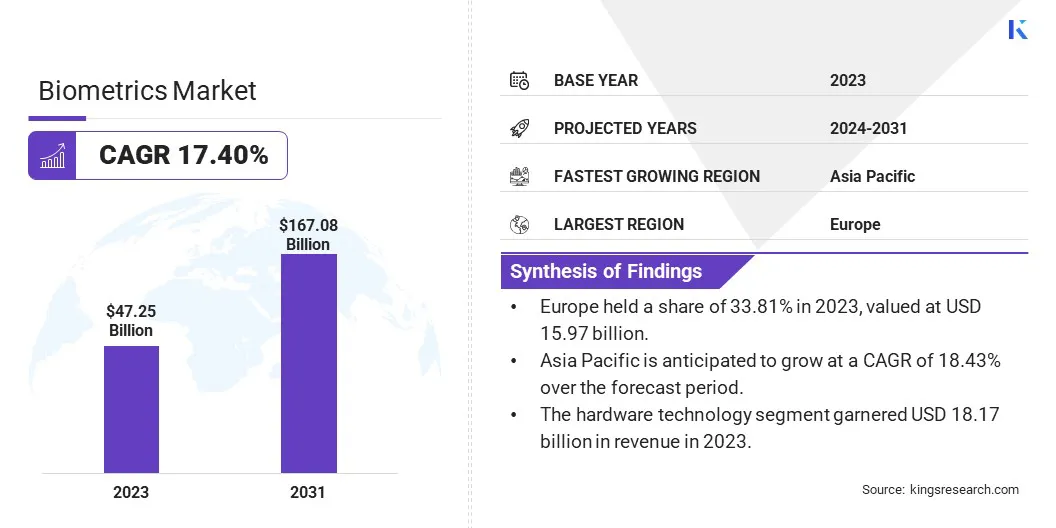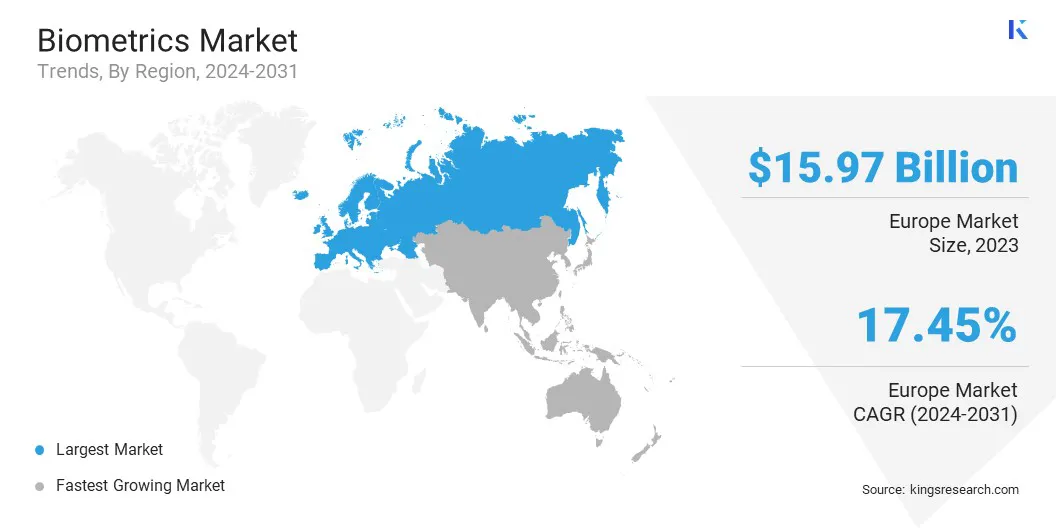Market Definition
The market involves technologies that authenticate identities using unique biological and behavioral traits, such as fingerprints, facial recognition, and voice patterns. Market growth is driven by the demand for secure, efficient authentication across sectors such as security, finance, healthcare, and consumer electronics. Advancements in accuracy and convenience are propelling widespread adoption and market growth.
Biometrics Market Overview
Global biometrics market size was valued at USD 47.25 billion in 2023, which is estimated to be valued at USD 54.34 billion in 2024 and reach USD 167.08 billion by 2031, growing at a CAGR of 17.40% from 2024 to 2031.
Rising concerns over identity theft, cyberattacks, and fraud are boosting the demand for more secure authentication methods. Biometrics systems, offering higher security, are becoming essential to protect sensitive data and transactions.
Major companies operating in the biometrics market are Thales, IDEMIA, NEC Corporation, ASSA ABLOY, Fujitsu, Aware, Inc., Precise Biometrics, Cognitec Systems GmbH, Daon, Inc, Leidos, BioID, Mitek Systems, Inc., FaceFirst, Inc., BioEnable , M2SYS Technology, and others.
The market is rapidly evolving, utilizing biological and behavioral traits for secure and efficient identity verification. Spanning various industries, it supports access control, fraud prevention, and secure transactions.
Growing demand for robust security measures boosts biometric systems adoption, providing a reliable alternative to traditional authentication methods. Market expansion is fueled by technological advancements and widespread adoption across sectors, including government, finance, and consumer electronics, with applications continually expanding globally for both personal and organizational use.
- In January 2025, BIO-key secured a contract with the Wyoming Department of Education to implement its PortalGuard IDaaS platform, enhancing security and user experience for up to 20,000 staff members. The solution provides Multi-Factor Authentication (MFA), Single Sign-On (SSO), and phishing-resistant access to critical digital resources and applications.
 Key Highlights:
Key Highlights:
- The biometrics industry size was recorded at USD 47.25 billion in 2023.
- The market is projected to grow at a CAGR of 17.40% from 2024 to 2031.
- Europe held a share of 33.81% in 2023, valued at USD 15.97 billion.
- The hardware technology segment garnered USD 18.17 billion in revenue in 2023.
- The IRIS recognition segment is expected to reach USD 41.04 billion by 2031.
- The contact segment generated a value of USD 17.89 billion in 2023.
- The government segment is expected to capture a share of 29.94% by 2031.
- Asia Pacific is anticipated to grow at a CAGR of 18.43% over the forecast period.
Market Driver
“Increasing Security Threats”
Rising concerns over identity theft, cyberattacks, and fraud are leading to the increased demand for more secure authentication methods, stimulating the growth of the biometrics market. As traditional passwords and PINs become increasingly vulnerable, biometrics offer a more reliable and secure alternative.
With their ability to accurately authenticate individuals based on unique biological traits, biometric systems provide enhanced security for personal and organizational data. This growing need for secure identity verification in various sectors is propelling the expansion of the market.
- In February 2025, BigBear.ai partnered with SoftPoint to integrate Trueface AI-powered facial biometric authentication for payment transactions, enhancing security across SoftPointPay platforms. This collaboration aims to reduce fraud, identity theft, and unauthorized access, setting new standards in biometric-driven payment security.
Market Challenge
"False Positives/Negatives"
False positives and negatives in biometrics is hindering the growth of the biometrics market by compromising system reliability and user experience. Inaccurate results, such as rejecting legitimate users or allowing unauthorized access, undermine trust and effectiveness. This challenge is particularly evident in fingerprint or facial recognition systems under poor conditions.
To mitigate this challenge, enhancing algorithms with machine learning can improve accuracy by adapting to various conditions. Additionally, integrating multi-factor authentication (MFA) offers enhanced security, minimizing risks related to false matches.
Market Trend
"Surging Adoption of Multi-Factor Authentication (MFA)"
The biometrics market is witnessing a rise in the adoption of Multi-Factor Authentication (MFA) as organizations increasingly integrate biometric systems to strengthen security.
By combining biometrics like fingerprint or facial recognition with other authentication methods, MFA provides an added layer of protection against unauthorized access. This trend is gaining traction across digital platforms, particularly in banking, e-commerce, and enterprise systems, where securing sensitive data is paramount. Amid rising cyber threats, biometric MFA is increasingly essential for robust security solutions.
- In January 2025, Entrust introduced AI-powered facial biometric authentication in its IDaaS platform, enhancing fraud prevention with password less, phishing-resistant MFA, and enabling secure digital onboarding and high-risk transaction protection using on-device biometric storage.
Biometrics Market Report Snapshot
|
Segmentation
|
Details
|
|
By Component
|
Hardware, Software, Services
|
|
By Type
|
IRIS Recognition, Hand Geometry, Facial Recognition, Signature Verification, Fingerprint, Voice Recognition, Others
|
|
By Technology
|
Contact, Non-contact, Hybrid
|
|
By Vertical
|
Government, BFSI, Healthcare, Defense & Security, Automotive, Others
|
|
By Region
|
North America: U.S., Canada, Mexico
|
|
Europe: France, UK, Spain, Germany, Italy, Russia, Rest of Europe
|
|
Asia-Pacific: China, Japan, India, Australia, ASEAN, South Korea, Rest of Asia-Pacific
|
|
Middle East & Africa: Turkey, UAE, Saudi Arabia, South Africa, Rest of Middle East & Africa
|
|
South America: Brazil, Argentina, Rest of South America
|
Market Segmentation
- By Component (Hardware, Software, and Services): The hardware segment earned USD 18.17 billion in 2023 due to increasing demand for biometric devices in security, healthcare, and consumer electronics applications.
- By Type (IRIS Recognition, Hand Geometry, Facial Recognition, Signature Verification, Fingerprint, Voice Recognition, and Others): The IRIS recognition segment held a share of 24.47% in 2023, largely attributed to its high accuracy and reliability in secure identification systems.
- By Technology (Contact, Non-contact, and Hybrid): The contact segment is projected to reach USD 63.16 billion by 2031, owing to the widespread use of fingerprint scanners in mobile devices and security systems.
- By Vertical (Government, BFSI, Healthcare, Defense & Security, Automotive, and Others): The automotive segment is anticipated to grow at a robust CAGR of 17.74% through the forecast period, aided by growing demand for biometric vehicle access and security systems.
Biometrics Market Regional Analysis
Based on region, the global market has been classified into North America, Europe, Asia Pacific, Middle East & Africa, and Latin America.
 Europe biometrics market captured a notable share of around 33.81% in 2023, valued at USD 15.97 billion. This dominance is reinforced by stringent data protection regulations and a high demand for advanced security solutions.
Europe biometrics market captured a notable share of around 33.81% in 2023, valued at USD 15.97 billion. This dominance is reinforced by stringent data protection regulations and a high demand for advanced security solutions.
The region’s strong focus on innovation, particularly in industries such as government, banking, and healthcare, has fueled the adoption of biometric technologies. Additionally, the presence of major players and the increasing use of biometrics in public services and financial sectors contribute to this growth.
Asia Pacific biometrics industry is set to grow at a staggering CAGR of 18.43% over the forecast period. This rapid expansion is propelled by ongoing technological advancements, increasing industrialization, and rising security concerns. Countries such as China, India, and Japan are seeing a surge in biometric applications across diverse sectors, including government, banking, and retail.
The growing middle-class population, rising smartphone penetration, and an expanding digital economy further accelerate the demand for biometric authentication. As businesses and governments prioritize secure access, Asia Pacific is expected to emerge as a key market for biometrics in the coming years.
- In December 2023, Mastercard partnered with NEC to launch facial recognition checkout systems in Asia. The pilot trials will begin in Singapore and Indonesia, leveraging NEC’s advanced biometric technology for seamless, secure, and contactless payment transactions, enhancing user experience.
Regulatory Frameworks
- In the EU, the General Data Protection Regulation (GDPR) defines the rights of data subjects, granting individuals greater control over their personal data. These enhanced rights empower individuals to have more control over how their personal data is collected, used, and stored.
- In India, the Digital Personal Data Protection Bill, 2023, governs the processing of digital personal data collected online, or digitized from offline sources. It also applies to data processing outside India if it involves offering goods or services within the country.
- In Illinois, the Biometric Information Privacy Act (BIPA), establishes standards for the collection and handling of biometric data from consumers.
Competitive Landscape
Companies operating in the biometrics market have introduced advanced solutions with enhanced accuracy, security, and user experience. These innovations include cutting-edge fingerprint, facial recognition, and iris scanning technologies for digital payments, access control, and identity verification, addressing growing security concerns and streamlining authentication processes in sectors such as finance and healthcare.
- For instance, in September 2024, NEC introduced an innovative biometric authentication system that efficiently identifies large groups in motion, reducing congestion in high-traffic areas. Using advanced facial recognition, it supports real-time authentication of up to 100 individuals per minute, enhancing operational efficiency globally.
List of Key Companies in Biometrics Market:
- Thales
- IDEMIA
- NEC Corporation
- ASSA ABLOY
- Fujitsu
- Aware, Inc.
- Precise Biometrics
- Cognitec Systems GmbH
- Daon, Inc
- Leidos
- BioID
- Mitek Systems, Inc.
- FaceFirst, Inc.
- BioEnable
- M2SYS Technology
Recent Developments (Partnership/Launch)
- In December 2024, NEC announced its technical support for the "null2" Signature Pavilion at Expo 2025, utilizing biometric authentication technology for secure digital identity verification. The system ensures privacy while enabling seamless self-sovereign identity management through facial recognition and digital human interaction.
- In January 2025, IDEX Biometrics, in partnership with LIFE CARD, launched Japan's first biometric payment cards. Set for commercial deployment in the first half of 2025, this solution enhances secure and seamless payments, reinforcing Japan’s leadership in payment technology.
- In January 2024, Continental introduced the world’s first Face Authentication Display, a biometric access control system for vehicles. Integrated behind the driver display and B-pillar, it uses facial recognition for secure, contactless vehicle access, enhancing both security and convenience.

 Key Highlights:
Key Highlights: Europe biometrics market captured a notable share of around 33.81% in 2023, valued at USD 15.97 billion. This dominance is reinforced by stringent data protection regulations and a high demand for advanced security solutions.
Europe biometrics market captured a notable share of around 33.81% in 2023, valued at USD 15.97 billion. This dominance is reinforced by stringent data protection regulations and a high demand for advanced security solutions.